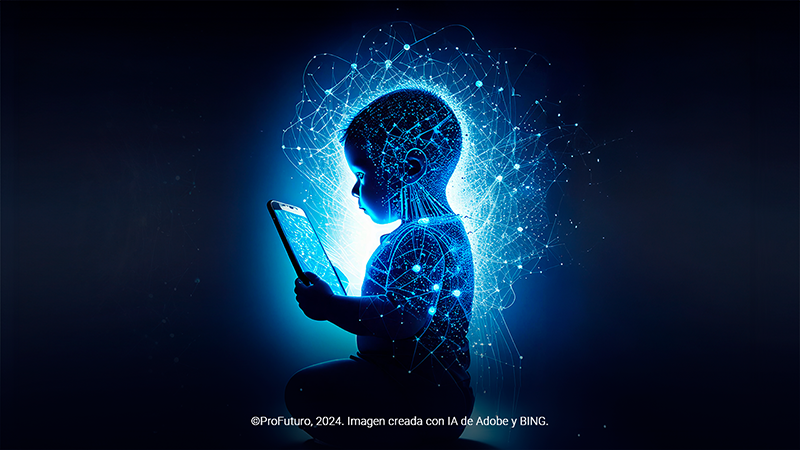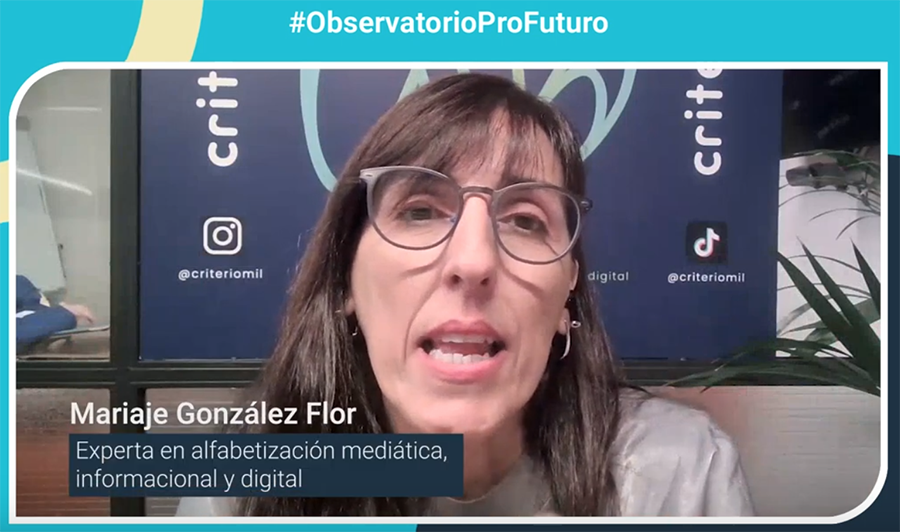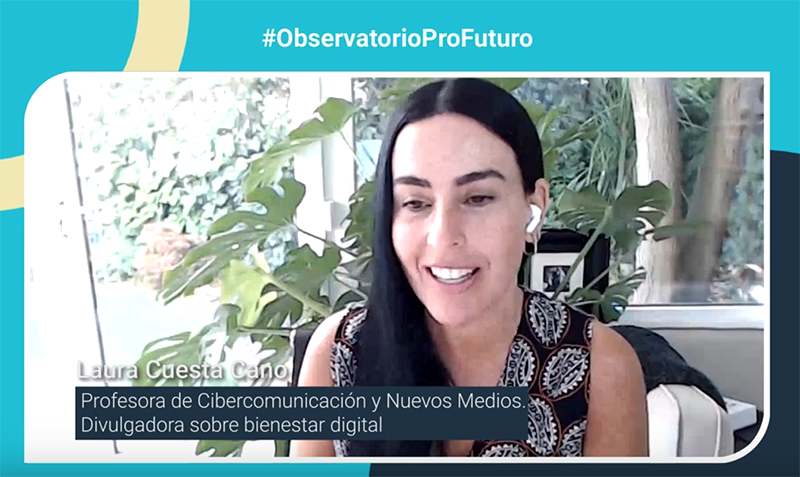Would you allow your four-year-old child to use a knife to cut their steak without teaching them how? Certainly not. Even after teaching them, you’d likely supervise them for some time before leaving them to use it alone. After all, though they might be “knife natives” because they were born centuries after this technology was invented, you know it is a useful yet dangerous tool if used without caution.
Let’s translate this situation to digital devices. Do you know how your children use their devices? What do they watch? Where do they go? Who do they contact? Have you ever considered that, just like with a knife, we should teach and accompany them in its use?
The Birth of a Myth

The concept of “digital natives” is based on the idea that young people who have grown up with constant access to digital devices, such as computers, smartphones, and gaming consoles, have developed a familiarity with technology that makes them more competent in its use than previous generations. This idea was popularised by technology and education expert Marc Prensky in his essay “Digital Natives, Digital Immigrants,” where he argued that this generation acquires new technological skills faster and prefers visual and multitasking environments over traditional media, such as books or linear texts.
This idea was quickly embraced by educators, policymakers, and technology experts who saw young people as the future of a fully technology-driven society. However, this perception overlooked the gap between frequent technology use and the ability to use it critically and effectively, leading some authors to speak not of digital natives but of digital orphans.
“Our children and young people today are digital orphans. When the concept of ‘digital native’ emerged, society mistakenly thought that just because they were born in this era, they came equipped with digital skills and competencies and therefore didn’t need support,” said Chilean educator Marcela Momberg, an expert in integrating new technologies into classrooms, in an interview with this Observatory. “Being left on their own to join the digital space from an early age without guidance, they have not developed the opportunities this space offers. If parents and teachers support them, their digital experience will be positive,” she continues.
Expert Laura Cuesta also highlights the dangers of accepting this myth without questioning it: “The worst part is that this false sense of competence has led some parents and educators to relax their supervision over children’s screen time. However, just because young people feel comfortable using digital devices does not mean they understand the risks involved, know how to protect their privacy, or manage the time they spend online effectively.”
Challenging the Concept with Evidence
Despite the widespread acceptance of the concept, several studies are showing that young people are not as competent in the critical use of technology as assumed. While they may know how to use apps and devices or navigate social media with ease, it’s quite a different matter to use these resources critically and wisely. Let’s look at some examples:
Evaluating Information
A key study by Wineburg and McGrew, titled Lateral Reading: Reading Less and Learning More When Evaluating Digital Information, examined how university students, historians, and fact-checkers assessed website credibility. Instead of demonstrating advanced critical evaluation skills, Stanford students, considered “digital natives,” were swayed by superficial characteristics, like visual design and formal logos, mistakenly relying on a site’s appearance to judge its credibility.
The study introduced the distinction between “vertical reading” and “lateral reading.” While vertical reading involves staying on a site to assess it, lateral reading means opening multiple tabs to compare information from different sources before reaching a conclusion. Fact-checkers, experts in assessing digital information credibility, use lateral reading to navigate the web critically and quickly. However, students rarely adopted this strategy, showing that their ability to navigate the digital environment is far from innate or automatic.
Quantitative vs. Qualitative Technology Use
Another key criticism of the digital natives concept is that it tends to equate frequent technology use with qualitative mastery. According to an article in Le Monde, students claim to be experts on the Internet, but they actually limit their use to recreational activities, like social media, and again show significant difficulties when faced with more complex tasks, such as finding reliable information. Although they are constantly connected, they tend to accept the first information they encounter without questioning it. Many assume that the first search results on engines like Google are the most trustworthy without investigating the source or assessing the site’s credibility. This “quantitative” use of technology, as opposed to the “qualitative” use that implies deep and critical understanding, falls short of the expected competence of a supposed “digital native.”
Inequality in Access and the Digital Divide
The concept of digital natives also overlooks significant differences in technology access and use. Not all young people have the same level of access to digital devices and the Internet, creating a divide between those who have opportunities and training to leverage technology and those who don’t. Alfonso Vázquez Atochero, in his essay The Myth of the Digital Native, argues that the true digital divide is not necessarily between generations but within the same generation of young people. While some have access to quality education that fosters critical thinking about technology, others lack these opportunities, resulting in a digital elite and a vulnerable population left behind.
This digital divide is particularly alarming, as those who do not acquire critical skills may be excluded from educational and employment opportunities in an increasingly digitalised society. Vázquez points out that merely being born in the digital age is not enough to master technology; proper training is essential to bridge this gap.
What Can Be Done?
Society’s response to the challenge of technological change cannot be to turn its back on it or shy away from technology in classrooms but to promote its use alongside the development of critical technological skills.
Digital Education and Media Literacy for Students and Teachers
To address the myth of digital natives, it is essential to introduce digital education and media and information literacy in schools. As we have seen, and as several studies confirm, familiarity with technology is not equivalent to competence. Schools should focus on teaching critical digital literacy skills from an early age, including teaching students to assess sources of information, use lateral reading to verify website credibility, and develop a critical mindset towards the information they consume.
Additionally, teachers must also receive training in these competencies so they can effectively guide their students. In many cases, teachers face the same lack of critical skills as students, exacerbating the problem of digital literacy in schools.
The Visitors and Residents Model: An Alternative
In contrast to Prensky’s dichotomy between digital natives and immigrants, White and Le Cornu proposed the “visitors” and “residents” model. In this model, “visitors” use the Internet as a tool for specific tasks without leaving a significant digital footprint. In contrast, “residents” see the web as a space where they develop their digital identity and actively participate in online communities.
This approach offers several advantages over Prensky’s dichotomy. For starters, it provides a richer and more complex view of how people interact with technology. By focusing on behaviour and motivations rather than age or generation, this model offers a more accurate understanding of how individuals navigate the digital world. Additionally, it provides a valuable tool for educators and professionals interested in promoting effective and critical digital literacy, avoiding simplistic assumptions that all young people are naturally proficient with technology just because they were born in the digital era.
Young people are not born with innate digital skills; like any other competence, these skills must be taught and developed. Ignoring this reality can have severe consequences, such as the perpetuation of misinformation and the lack of critical thinking in an increasingly digital society. To bridge the gap in digital literacy, it is essential that educational systems adopt a more conscious and critical approach to teaching technology. Students need to be trained not only to use devices but to do so in ways that enable them to evaluate, verify, and reflect on the information they find online. Only in this way can they become responsible digital citizens prepared to face the challenges of the future.
Sources
- Le Monde. (2010). Les élèves ne sont pas aussi à l’aise qu’on veut bien le dire avec Internet.
- Vázquez Atochero, A. (2015). The Myth of the Digital Native: Rethinking the Prenskian Paradigm. Universidad de Extremadura.
- White, D., & Le Cornu, A. (2012). Visitors and Residents: A New Typology for Online Engagement. First Monday, 16(9). https://doi.org/10.5210/fm.v16i9.3171
- Wineburg, S., & McGrew, S. (2017). Lateral Reading: Reading Less and Learning More When Evaluating Digital Information. Stanford History Education Group.






